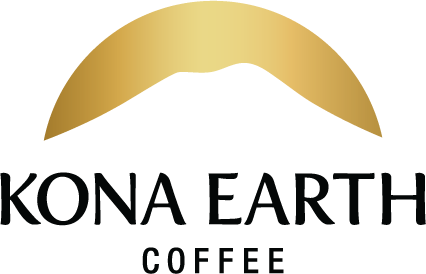Kona Earth - About Kona Coffee
Kona coffee represents a tiny fraction of the worldwide specialty coffee market. Still, it is universally prized among coffee connoisseurs for its quality and flavor. Below, we list a few contributing factors to Kona Coffee's beloved status:
Geography
Kona Coffee Belt on Hawaii's Big Island
The Kona Coffee Belt is a tiny strip of land on the western side of Hawai'i's Big Island. Just a few miles wide and about 30 miles long, the area is blessed with ideal coffee-growing conditions. It combines a mild, tropical climate with minor temperature variations, mineral-rich, volcanic soil, and elevations between 800 and 2500 feet. Only grown in this region, Kona Typica (an Arabica varietal) has a well-earned reputation for consistent high quality and excellence that keeps Kona coffee fans coming back for more.

Kona Earth owners Steve and Joanie Wynn walk their farm
Kona Earth's farm is located at approximately 2200 feet in elevation on the tropical slopes of the Hualalai volcano. At that altitude, we have cooler temperatures and more rain. Sunny mornings give way to cloudy afternoons with almost daily rain showers. This provides the perfect combination of sun and moisture for optimal tree growth. The micro-climate allows our trees to mature slowly, giving the fruit more time to develop and ripen. This translates to lush fruit, large beans, and robust flavor.
Another benefit to Kona Earth's farm is that we have a lot of rich, volcanic soil, whereas many Kona coffee farms grow right out of rock.
Quality

Kona coffee production at Kona Earth
Authentic Hawaiian Kona Coffee commands some of the highest prices in the world. Why is that?
- The small geographic region Kona coffee represents means that supply is naturally limited. This makes it rare and, thus, more valuable than coffee abundantly available from more significant coffee-producing regions like Columbia or Costa Rica.
- Unlike large, mechanized farms in other regions, Kona coffee is hand-picked. Even though this method is more labor-intensive and expensive, it is more selective. Only ripe, red cherry is picked throughout multiple rounds within a harvest season. Green fruit is left to ripen on the trees and picked on subsequent rounds. Gathering fruit at its optimal ripeness avoids the bitterness of green fruit processing.
- Grown in the United States, and unlike most coffee-producing regions worldwide, farm workers are paid a living wage.
Kona Coffee Farming Costs
Most Kona coffee farms are small, family-run operations. As a rule of thumb, it costs the farmer about ten dollars to pick the fruit, which results in one pound of coffee. Add to this the costs of operating the farm (the inputs or materials used to support the crop, equipment costs, fuel, etc.) and the costs of processing the coffee. Next, add the cost of land leases or mortgages, taxes, and other overhead expenses. Finally, marketing, sales, packaging, and shipping costs should be added to get the roasted coffee into customers' hands. With these factors in mind, it is understandable that a pound of Kona coffee yields an average price of between $50 and $70 per pound. Most coffee lovers think it's worth the splurge and, as a price per cup, 100% Kona Coffee is still an excellent value for a premium gourmet specialty product.
Don't Be Fooled
Finally, authentic Kona Coffee grows only in the Kona coffee belt region. However, lesser quality “Kona blends” abound, many containing just 10% of beans from Kona mixed with cheaper, low-quality beans from other regions. If you want an authentic Kona coffee experience, always look for 100% Kona Coffee on the label and buy from a reputable source. That's the only way to be sure you're getting the real thing.
More questions? Check out our FAQ's or get in touch and we'll do our best to answer any questions you may have.


